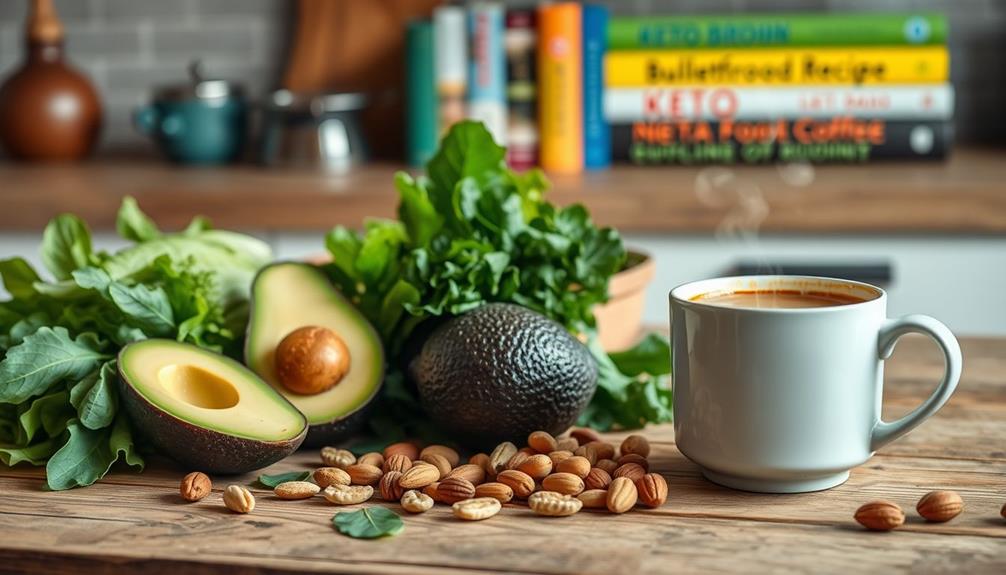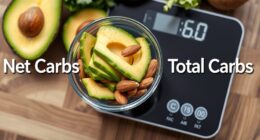The Keto Diet is a high-fat, low-carbohydrate eating plan that helps you enter ketosis, where your body burns fat for energy instead of carbs. You'll limit your carbohydrate intake to 20-50 grams per day, focusing on foods like meats, eggs, dairy, and healthy fats while avoiding bread and sugary foods. Typically, you'll aim for around 70-75% of your daily calories from fat. This diet can promote weight loss, improve blood sugar control, and boost cognitive function. If you want to explore how to effectively implement this lifestyle, there's plenty more to uncover.
Key Takeaways
- The Keto Diet is a high-fat, low-carbohydrate eating plan that promotes fat burning for energy by inducing ketosis.
- Daily carb intake is limited to 20-50 grams to maintain ketosis, with a typical macronutrient ratio of 70-75% fat, 20-25% protein, and 5-10% carbohydrates.
- Recommended foods include meats, eggs, dairy, and healthy fats, while avoiding bread, pasta, and sugary items.
- The diet can offer significant weight loss, improved blood sugar control, and enhanced cognitive function.
- Potential risks include "keto flu," nutritional deficiencies, and challenges in long-term maintenance; consultation with a healthcare professional is advised for individuals with health conditions.
Overview of the Keto Diet

The ketogenic diet, often referred to simply as keto, is a high-fat, low-carbohydrate eating plan designed to shift your body into a state called ketosis. By limiting your carb intake to about 20-50 grams per day, the keto diet encourages your body to burn fat for energy instead of carbohydrates. This metabolic shift can lead to rapid weight loss, making it a popular choice for those looking to shed pounds. To be successful on the keto diet, it’s important to focus on consuming healthy fats, such as avocados, nuts, and olive oil, while minimizing your intake of processed and sugary foods. Additionally, it’s helpful to track your carb intake and prioritize incorporating non-starchy vegetables and lean proteins into your meals. Following these keto diet plan tips can help support your body’s transition into ketosis and promote sustainable weight loss.
Additionally, incorporating foods rich in antioxidants, such as celery juice, can complement the health benefits of a keto diet by promoting hydration and supporting digestive health.
Originally developed for epilepsy treatment, the ketogenic diet has gained traction for its potential benefits in improving insulin sensitivity, particularly for individuals with type 2 diabetes. You'll find that common food choices on the keto diet include meats, eggs, dairy, and healthy fats like avocados and olive oil, while strict avoidance of high-carb foods such as bread, pasta, and sugary items is essential.
Keep in mind that during the initial phase of the diet, you might experience what's known as the "keto flu." This can involve fatigue, headaches, and digestive discomfort as your body adjusts to ketosis.
With patience and commitment, you can successfully navigate these early challenges and enjoy the benefits of a ketogenic lifestyle.
Macronutrient Breakdown
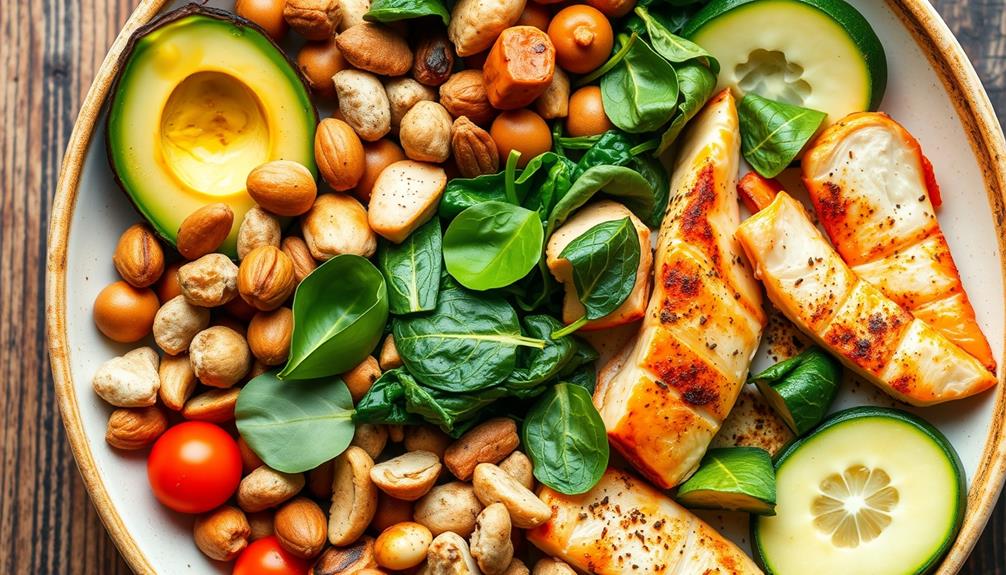
Understanding the macronutrient breakdown is key to successfully following the ketogenic diet. This diet typically emphasizes a specific ratio of macronutrients to induce ketosis, which is essential for burning fat instead of carbohydrates. Incorporating effective strategies for weight loss can enhance your success on this diet.
Your daily intake should consist of approximately:
- 70-75% fat
- 20-25% protein
- 5-10% carbohydrates
To maintain ketosis, limiting your daily carbohydrate intake to 20-50 grams is critical, with net carbs calculated by subtracting fiber from total carbohydrates. For protein, the recommendation is about 1 gram per kilogram of body weight, ensuring you get enough while keeping carbs low.
The Standard Ketogenic Diet (SKD) follows the traditional macronutrient breakdown, while variations like the High-Protein Ketogenic Diet (HPKD) adjust protein levels to about 35%.
Tracking macronutrient intake is essential for achieving and maintaining ketosis, so careful meal planning is necessary. By adhering to these ratios, you can effectively shift your body into a fat-burning state, maximizing the benefits of the ketogenic diet.
Health Benefits
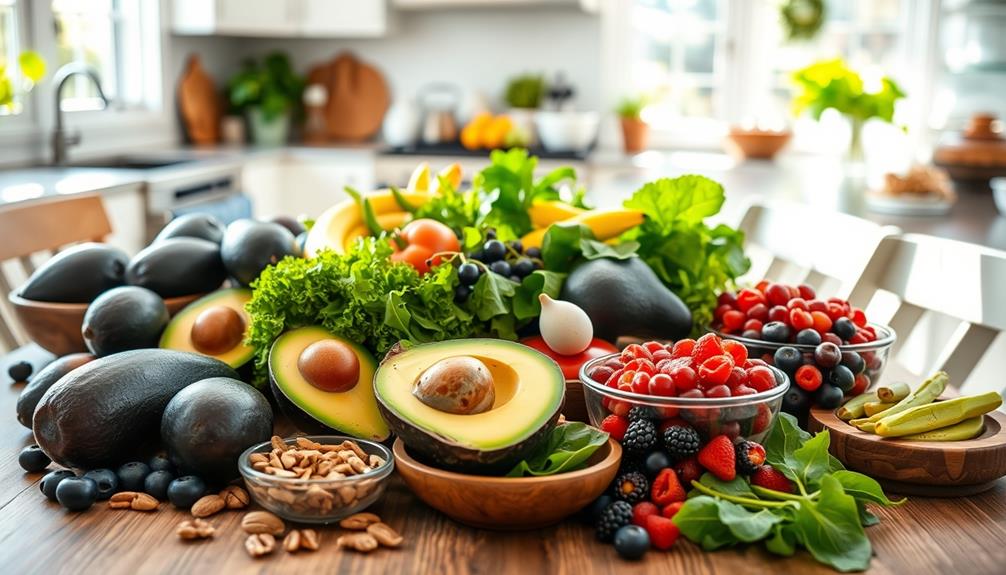
What if you could transform your health while shedding pounds? The keto diet helps you achieve just that. By adopting a high-fat diet, your body enters a metabolic state called ketosis, where it burns fat for fuel instead of carbohydrates. This shift can lead to significant weight loss, with studies showing participants losing an average of 2 pounds more than those on low-fat diets within the first few months.
Budgeting for health can also play an essential role in maintaining your new lifestyle and ensuring you have the resources to support your dietary choices.
Beyond weight loss, the health benefits of the keto diet are impressive. It's been shown to improve blood sugar control and insulin sensitivity, leading to about 60% of type 2 diabetes patients reversing their condition.
Additionally, the keto diet can enhance cognitive function, as your brain efficiently utilizes ketones produced during ketosis.
Moreover, the diet can positively affect cholesterol levels by lowering triglycerides and increasing HDL cholesterol, potentially improving cardiovascular health markers.
Whether you're looking to lose weight and improve your overall health or manage diabetes, the keto diet offers a promising approach that could transform your well-being.
Potential Risks

Beginning the keto diet can come with its own set of challenges and potential risks. As your body adjusts to ketosis, you might experience keto flu symptoms like fatigue, headache, nausea, and irritability.
Additionally, the restrictive nature of this high-fat diet can lead to nutritional deficiencies, so careful meal planning is essential. It's also important to contemplate potential interactions with any medications you may be taking, such as cold medications, which might've side effects when combined with a high-fat diet potential side effects and interactions.
Here are a few risks to contemplate:
- Increased cholesterol levels: Long-term adherence to the diet may elevate your cholesterol, requiring regular monitoring of cardiovascular health.
- Pre-existing health conditions: If you have conditions like kidney failure or liver disease, consult a healthcare professional before starting the diet.
- Weight regain: The restrictive nature of keto can make it hard to maintain long-term, possibly leading to a return to previous eating habits and weight regain.
It's vital to be aware of these potential risks as you initiate your keto journey. Ensuring you stay informed and vigilant will help you navigate this diet more safely.
Always listen to your body and make adjustments as needed to support your health and well-being.
Meal Planning Tips
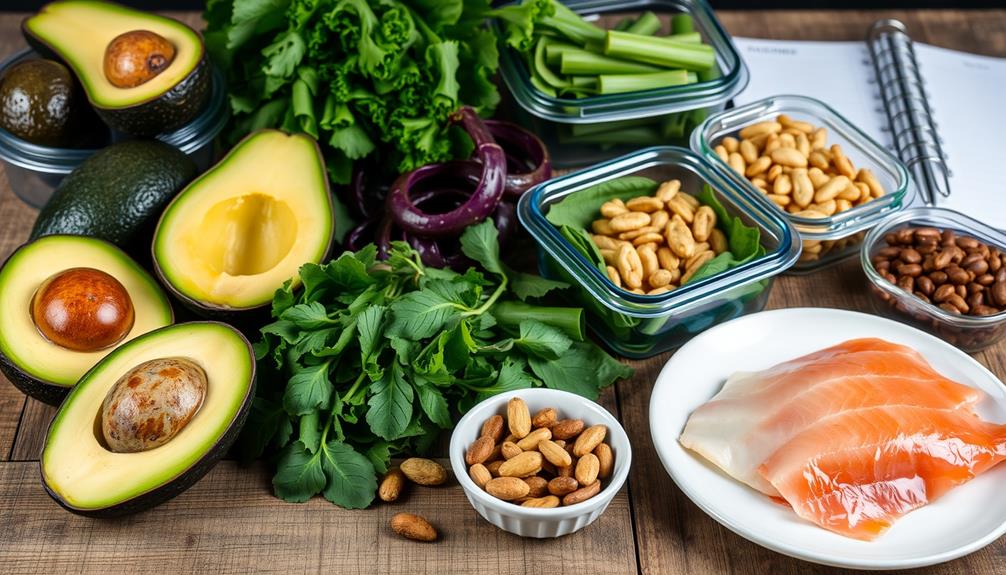
When you immerse yourself in the keto diet, effective meal planning is vital for staying on track and avoiding high-carb temptations. Start by meal prepping to guarantee you have keto-friendly snacks on hand. Think nuts, cheese, and olives to keep cravings at bay.
Additionally, incorporating elements from nature-inspired designs can enhance your kitchen or dining area, creating a conducive environment for your meal prep efforts. Cottagecore aesthetic promotes tranquility and can make your cooking experience more enjoyable.
Plan your meals around high-fat foods like avocados, fatty fish, and grass-fed meats, while also incorporating low-carb vegetables such as spinach, zucchini, and broccoli for balanced nutrition.
It's essential to track your macronutrient intake closely. Aim for a daily composition of 70-75% fats, 20-25% protein, and 5-10% carbohydrates to maintain ketosis effectively. Utilize online resources and keto-specific cookbooks for meal ideas that fit within these guidelines, making adherence simpler.
When dining out, don't forget to explore your options ahead of time. Choose meals that can be easily modified to be low-carb, like salads topped with grilled protein instead of bread or rice.
With these meal planning tips, you'll set yourself up for success on your ketogenic meal journey, staying satisfied and sticking to your goals.
Resources for Beginners

As you start your keto journey, having the right resources can make all the difference.
Utilizing numerous varieties of ingredients can help you create delicious meals while staying within your dietary goals. From meal planning tools and cookbooks to online support communities, you'll find plenty of ways to stay motivated and informed.
Let's explore some essential resources that can help you succeed on your keto diet.
Essential Keto Resources
Starting on a ketogenic diet can feel overwhelming, but plenty of essential resources are designed to guide beginners through the process. You can leverage a variety of tools and platforms to guarantee you stay on track with your weight loss goals.
Exploring different brewing methods can also help you find low-carb coffee options that fit your keto lifestyle.
Here are three key resources to take into account:
- Keto Diet Blog: This blog offers a treasure trove of recipes and meal plans tailored specifically for the ketogenic diet, making it easy for you to navigate your new lifestyle.
- Cleveland Clinic: Their Functional Ketogenics Program provides expert insights and guidelines to help you implement the keto diet safely and effectively.
- Online forums and support groups: Joining these communities can enhance your motivation. You'll find others who share their experiences and tips, which can be invaluable on your journey.
Additionally, think about investing in cookbooks like "Keto: The Complete Guide to Success" to keep you within your macronutrient targets.
Don't forget about health tools and calculators that help you track your macronutrient intake and progress. With these resources at your fingertips, you'll be well-equipped to thrive on your ketogenic journey.
Meal Planning Tools
Meal planning tools are essential for anyone diving into the ketogenic diet, especially beginners. To effectively manage your macronutrient intake, consider using online meal planning tools and apps like MyFitnessPal or Cronometer. These tools help you stay within the recommended limits of 70-75% fat, 20-25% protein, and 5-10% carbohydrates.
Additionally, exploring various earning methods can provide you with supplemental income to invest in your meal planning journey.
Explore keto-specific meal prep websites, such as Keto Diet Blog or Ruled.me, which offer a variety of recipes, structured meal plans, and grocery lists tailored for beginners. Investing in keto cookbooks like "The Complete Ketogenic Diet for Beginners" is also a smart move, as they provide detailed nutritional information and easy-to-follow meal plans.
If you're looking for convenience, meal delivery services like Snap Kitchen or Trifecta cater to ketogenic diets, ensuring you have compliant meals ready to go.
Additionally, engaging with online communities focused on the ketogenic diet, such as Reddit's r/keto, can be invaluable. These platforms allow you to share meal plans and tips, making your journey smoother and more enjoyable.
With these meal planning tools at your disposal, sticking to your keto goals becomes much easier.
Online Support Communities
Numerous online support communities can be a game-changer for beginners on the ketogenic diet. These platforms provide a wealth of resources, encouragement, and shared experiences that can make your journey smoother.
For instance, you can connect with others on Reddit's r/keto or in various Facebook groups, where you'll find meal plans, recipes, and motivational stories that can inspire you. Engaging with these communities can also enhance your emotional well-being, similar to how nature exposure improves mental health and supports manifestation abilities.
Here are some valuable resources to explore:
- KetoConnect and Diet Doctor: These websites offer extensive meal plans and beginner-friendly recipes.
- The Keto Diet Blog: Join the community forum to ask questions and discuss challenges with fellow keto enthusiasts.
- Keto influencers on social media: Follow them on Instagram and Pinterest for meal ideas and success stories.
Additionally, consider seeking personalized guidance through online coaching services or virtual consultations with registered dietitians specializing in the ketogenic diet.
Engaging with these online support communities can provide you with the encouragement and information you need to thrive on your keto journey. Take advantage of the collective knowledge and experience available, and don't hesitate to share your own insights as well!
Frequently Asked Questions
What Foods Are in a Keto Diet?
In a keto diet, you'll focus on high-fat foods like avocados and nuts, moderate proteins like meats and eggs, and low-carb veggies such as leafy greens, while avoiding sugars and starchy foods.
What Are the Basic Rules of a Keto Diet?
To effectively follow a keto diet, you'll need to limit carbs to 20-50 grams daily, focus on high-fat foods, and track your macronutrients to maintain ketosis for ideal weight loss and health benefits.
What Food Is Not Allowed in Keto?
Imagine a treasure chest overflowing with carbs—bread, pasta, and sugary treats. You'll need to lock that chest away! Avoid starchy veggies, most fruits, and processed foods to stay on track with your keto journey.
What Is the Basic Idea of Keto Diet?
The basic idea of keto's to cut carbs drastically, pushing your body into ketosis. You'll burn fat for energy instead of carbs. It can lead to quick weight loss and improved metabolic health.
Conclusion
To summarize, the keto diet transforms your body into a fat-burning machine, shifts your energy source from carbs to fats, and can lead to impressive health benefits. While you enjoy delicious low-carb meals, you should also be aware of potential risks. With proper meal planning and resources, you can navigate this lifestyle with confidence. Embrace the journey, savor the flavors, and discover a healthier you as you experience the power of the keto diet.



